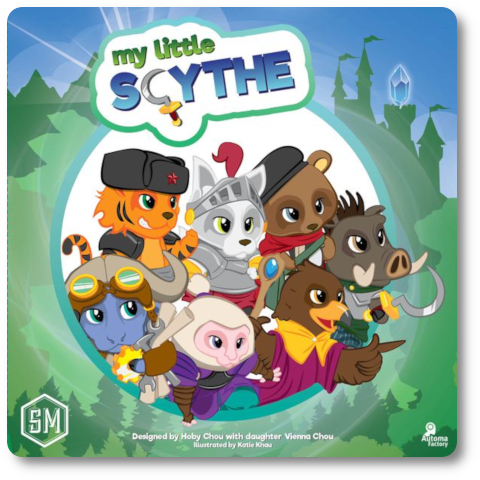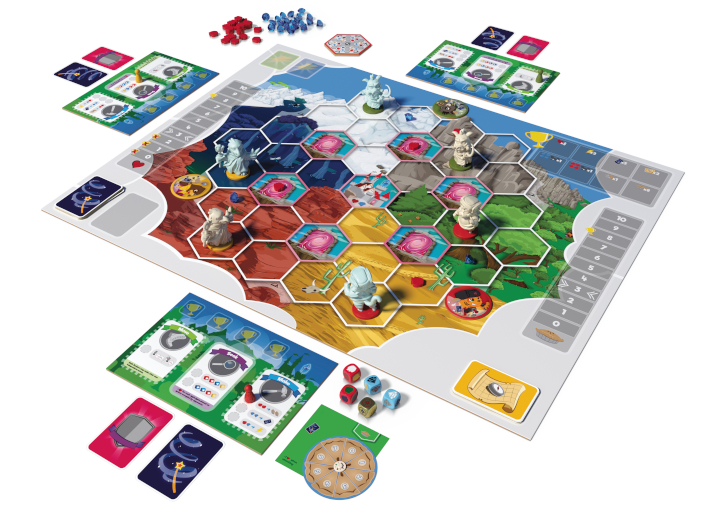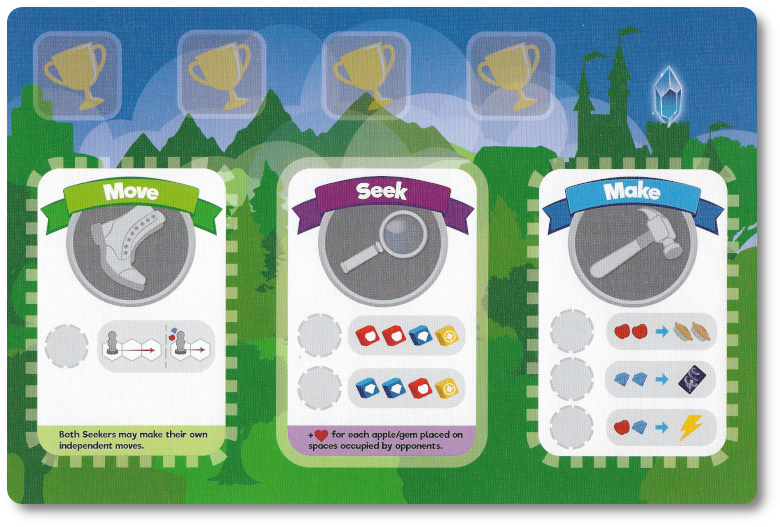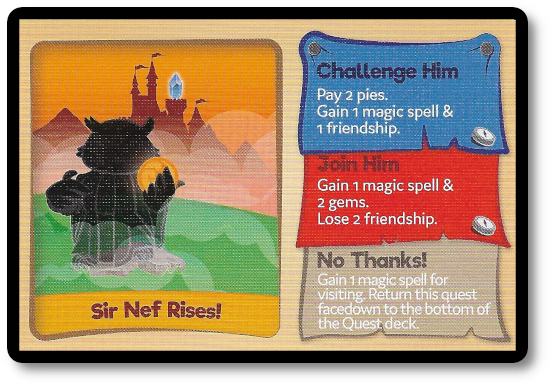
The Basics:
- For ages 8 and up
- For 1 to 6 players
- Approximately 60 minutes to complete
Geek Skills:
- Active Listening & Communication
- Counting & Math
- Logical & Critical Decision Making
- Reading
- Strategy & Tactics
- Risk vs. Reward
- Cooperative & Team Play
- Hand/Resource Management
Learning Curve:
- Child – Easy
- Adult – Easy
Theme & Narrative:
- Friendship and kingdom domination go hand in hand!
Endorsements:
- Gamer Geek mixed!
- Parent Geek approved!
- Child Geek approved!
Overview
American actor, writer, comedian, and voice actor, J.B. Smoove, said “You got to start by doing little things if your quest is to take over the world.” In this game, players will earn the right for their kingdom to rule over all, but not through force of strength or contest of will. Acts of kindness and the gathering of resources for the betterment of all is the path to the throne. The kingdom is yours for the taking, reaping the rewards that come with power, one small step at a time.
My Little Sycthe, designed by Hoby Chou, Vienna Chou and published by Stonemaier Games, is comprise of one game board, 30 Magic Spell cards, 12 Quest cards, 24 Apple tokens, 25 Magic Gem tokens, 12 Quest tokens, 14 Seeker miniatures (in unique pairs of two), two Pie Fight dials, seven Action tokens, seven Pie tokens, one Setup tile, six Player mats, 28 Trophy tokens, seven Base Camp tiles, 16 Power Up tiles, eight Personality cards, seven Friendship tokens, and five Search dice (custom six-sided die). The game component quality is excellent, as I have come to expect from Stonemaier Games. The miniatures depict humanoid animal siblings that are adorable (a painting guide is provided with the game for those who care to make their miniatures even more impressive). Tokens, cards, and the game board are solid and durable.
The Animal Kingdom of Pomme
To set up the game, first place the game board in the middle of the playing area where all players can easily reach it.
Second, have each player select an animal kingdom, placing the matching Base Camp tile on the game board position (which is based on the number of players in the game). Any unused Base Camp tiles should be returned to the game box at this time.
Third, have each player take a Player mat, one Action token, and matching Seeker miniature set.
Fourth, place four Trophy tokens on the designated game board space and have the players place their Friendship tokens and Pie tokens on the designed tracks found on the game board.
Fifth, shuffle the Quest and Magic Spell cards. Place the Quest deck face-down on the game board and deal one Magic Spell card to each player. After dealing the cards, place the Magic Spell deck face-down, as well. These are the Quest and Magic Spell draw decks for the duration of the game.
Sixth, shuffle the Power Up tiles and place in their respective stacks face-down on the game board.
Seventh, place the Setup tile face-down and randomly orientate it on the center “Castle Everfree” space found on the game board. Flip the Setup tile over. Take the matching resources and place on the three spaces in front of each player’s Base Camp tile. The Setup tile is then placed back in the game box.
Eighth, each player now places their Seeker miniatures on their Base Camp tile and shuffle the Personality cards. Deal one Personality card to each player. Return any Personality cards not used to the game box. Personality cards adjust a player’s Seekers, providing each player a unique set of Seeker siblings. The Personality card will make it easier for the player to earn certain trophies. However, a player’s Friendship value will indicate if the Personality card ability can be used or not.

That’s it for game set up. It should look similar to the following image. Determine who will be the first player and begin.

Original image courtesy of Stonemaier Games
Go Quest, Young Siblings
My Little Scythe is played in rounds and turns with no set number of rounds per game. On a player’s turn, they select one of six possible actions from three different categories (Move, Seek, and Make), indicating the action they select by placing their Action token on the matching space found on their Player mat. Players must always select a different action than the action taken on their previous turn. Each of the actions per category are summarized here and are considered “generic”. They can be changed during the game by a player acquiring a Power Up tile, which changes the available actions.

Move
The Move category only provides one action that allows the player to move one or both of their Seeker miniatures on the game board one or more spaces. All hexagon shaped areas on the map are considered a “space”. A players’ Base Camp, however, is not. Players can only return to their Base Camp tile after they leave it through teleportation triggered by dropping off goods or losing Pie Fights. Returning to the Base Camp tile “rejuvenates” the player’s Seekers, giving the player one Magic Spell card and two pies (noted on the Pie track). It also removes the player’s Action token from their Player mat, giving the player the ability to select any action on their next turn.
There are two different types of movement.
- Move Seeker up to two spaces that are not carrying any Apple or Gem tokens. Movement stops if the Seeker enters a space already occupied by another Seeker. This will initiate a Pie Fight.
- Move Seeker one space that is carrying Apple or Gem tokens.
Moving the Seeker who is carrying exactly four Apple tokens and four Gem tokens to the Castle Everfree space allows the player to deliver the carried goods. Doing so earns the player a matching Trophy token. The Trophy token is placed on the player’s Player mat. Once the delivery is made, the Seeker miniature is immediately placed back on the player’s Base Camp tile.
Some spaces in the game are “Portals”. All Portals are considered adjacent to each other, allowing the player to move great distances on the game board. Castle Everfree is on such a Portal space, but can only be jumped to if the player’s Seeker is able to make a delivery.
A Pie Fight is initiated if a player moves their Seeker (who is not carrying any tokens) into a space occupied by an opponent’s Seeker. This is considered an aggressive move and reduces the player’s Friendship value by minus one. Pie Fights are resolved by the two players taking the Pie Fight dial. The dial indicates the number of pies each player’s Seeker will be throwing. The number selected may not be greater than the player’s total pies shown on the Pie track. A player may add a Magic Spell card, attaching it to whatever number of pies they decide to throw. The value of the Magic Spell is added to the number of pies selected on the dial. Both players then reveals their dial (and Magic Spell cards if used). The player with the fewer pies thrown looses the Pie Fight and must immediately relocate their Seeker to their Base Camp tile, but they must drop any carried tokens before doing so. The winner earns a Trophy token. Both players reduce the number of pies available to them on the Pie track.

Fiery pies of fiery doom!
After movement (and any Pie Fights), if the player’s Seeker is in a space with a Quest token, the token is removed and a Quest card is drawn. The quest must now be resolved. If the quest is resolved, the player keeps it, placing it next to their Player mat. If the player chooses not to resolve the quest (by saying “No Thanks”), it’s placed on the bottom of the Quest draw deck.

Seek
The Seek category has two different actions. Both actions allow the player to roll four dice, but the type (color) of dice is different. Red dice will provide Apple tokens, blue will provide Gem tokens, and yellow (gold) will provide Quest tokens. The dice are rolled and the color for on the die indicates the region in which the token is placed by the player (player’s choice here). White indicates tundra, grey for mountains, blue for swamp, green for forest, red for rock, and yellow for desert.
If a player places an Apple or Gem token in the same space occupied by an opponent’s Seeker, they gain Friendship. A nice touch by the game designer.
Make
The Make category has three different actions. These actions allow the player to “Bake Pies” (exchange two Apple tokens for increasing Pie track value by two), “Conjure Spell” (exchange two Gem tokens for one Magic Spell card), or “Power Up” (exchange one Apple token and one Gem token to obtain a Power Up tile). Earned Power Up tiles are placed on the players Player Mat, replacing the default actions in the matching category. Only one Power Up tile is possible per category, but the upgrade is permanent.
It’s All About the Trophies
Throughout the game, players will be selecting different actions. The goal is to take actions that will eventually lead to earning a trophy. There are eight different trophy types available and a player can only earn one trophy from each type. Trophies are earned from winning Pie Fights, completing quests, having a high Friendship value, powering up the Seekers, collecting magic spells, delivering tokens, and obtaining pies. Trophy tokens are collected and placed on the Player mat. Only one trophy can be collected per turn until the endgame is triggered. At which point, a player may earn as many as possible on their final turn. It should be noted that some trophies are easier to get than others. For example, a player need only win a Pie Fight to earn the Pie Fight trophy.
Discover Your Destiny
As the game progresses, players will earn Trophy tokens. When one or more players have earned their fourth trophy at the end of their turn, the endgame is triggered. Turn order continues, with the players who have fewer than four trophies taking a final turn. After all players have had their final turn, the number of trophies earned are counted by each player. The player with the most trophies wins the game.
Game Variants
My Little Scythe can be played as a solitaire game against a game-driven opponent named “Automountie”. Automountie is “smart” enough to be added to games with two or more players, too, allowing for a seventh pair of Seekers to be in the game. Automountie is set to a difficulty level, which indicates the starting Pie track level and number of starting resources and Quest tokens that are required to earn trophies. What Automountie does on its turn is determined by drawing an Automountie card and resolving it. Automountie will earn pies, go on quests, and even engage the player in a Pie Fight.
Teams can also play the game, against other human players or Automountie teams.
To learn more about My Little Scythe, visit the game’s web page.
Final Word
A quick note before we continue. All of our players, save one, have played Scythe, the bigger and more complicated game on which My Little Scythe is based. My Little Scythe is best thought of as a streamlined and simpler version of the bigger game. As such, our players were advised to review My Little Scythe on the game play it provided, avoiding any comparisons between the two games. Which proved to be a pointless exercise and effort on my part, because how can you not?
 The Child Geeks loved the game. From young and casual players to more experienced, they all found the game to be entertaining. But not necessarily fully engaging. According to one Child Geek who has played many games that are more complex than My Little Scythe, “I liked it. A bit easy and obvious what you always need to do, but I always felt like I was interested in the game and my turn always allowed me to work towards victory.” A less experienced and more casual Child Geek said, “I love my animal brother and sister and taking them on a quest to get apples and make pies and cast magic spells that I use in my pie fights!!!!! I LOVE THIS GAME!!!” That’s a direct quote and I didn’t want to add in my normal level of grammar correction due to how terribly excited she was about the game. When all the animal siblings returned to Base Camp, trophies in hand, the Child Geeks gave the game a first place trophy of its very own.
The Child Geeks loved the game. From young and casual players to more experienced, they all found the game to be entertaining. But not necessarily fully engaging. According to one Child Geek who has played many games that are more complex than My Little Scythe, “I liked it. A bit easy and obvious what you always need to do, but I always felt like I was interested in the game and my turn always allowed me to work towards victory.” A less experienced and more casual Child Geek said, “I love my animal brother and sister and taking them on a quest to get apples and make pies and cast magic spells that I use in my pie fights!!!!! I LOVE THIS GAME!!!” That’s a direct quote and I didn’t want to add in my normal level of grammar correction due to how terribly excited she was about the game. When all the animal siblings returned to Base Camp, trophies in hand, the Child Geeks gave the game a first place trophy of its very own.
 The Parent Geeks, like the Child Geeks, come in two different groups. The casuals and the experienced. Both groups, again just like the Child Geeks, found My Little Scythe to be a great time. According to one casual Parent Geek, “A surprisingly easy game to grasp despite its many parts. I thought I would be overwhelmed, but it turned out I was underwhelmed, in a good way! I was underwhelmed with how poorly I did! I look forward to playing this game again and soon.” A more experienced Parent Geek said, “A light game that requires the player to think through their moves, both acting and reacting. I like how balanced the game is, giving players the ability to try new strategies and tactics, giving meaningful feedback per the results of the actions taken. Great little game I’ll play again with family and friends.” All the Parent Geeks fully endorsed My Little Scythe.
The Parent Geeks, like the Child Geeks, come in two different groups. The casuals and the experienced. Both groups, again just like the Child Geeks, found My Little Scythe to be a great time. According to one casual Parent Geek, “A surprisingly easy game to grasp despite its many parts. I thought I would be overwhelmed, but it turned out I was underwhelmed, in a good way! I was underwhelmed with how poorly I did! I look forward to playing this game again and soon.” A more experienced Parent Geek said, “A light game that requires the player to think through their moves, both acting and reacting. I like how balanced the game is, giving players the ability to try new strategies and tactics, giving meaningful feedback per the results of the actions taken. Great little game I’ll play again with family and friends.” All the Parent Geeks fully endorsed My Little Scythe.
 The Gamer Geeks also come in two different groups. The open-minded and the elitists. Both groups are hard on games. In this case, both groups played and found something they enjoyed about the game. According to an open-minded Gamer Geek, “A simpler and more streamlined version of one of my favorite games. I would never play this game over the other, but I must admit, I enjoyed myself. I think this is a great game for my family and one I would happily play with them.” An elitist Gamer Geek said, “Way too simple for me and not nearly the kind of depth or strategy I look for if I am going to bother with a game. But I will say this. The game didn’t bore me and I even found myself entertained from time to time. I won’t be playing this game again, but I didn’t hate the game.” When the Gamer Geeks were done and the game put away, they sipped their beers, thought quietly, and then voted. To them, this group of gamers, My Little Scythe was a game they approved of, but would not necessarily put on their gaming table, resulting in a mixed endorsement.
The Gamer Geeks also come in two different groups. The open-minded and the elitists. Both groups are hard on games. In this case, both groups played and found something they enjoyed about the game. According to an open-minded Gamer Geek, “A simpler and more streamlined version of one of my favorite games. I would never play this game over the other, but I must admit, I enjoyed myself. I think this is a great game for my family and one I would happily play with them.” An elitist Gamer Geek said, “Way too simple for me and not nearly the kind of depth or strategy I look for if I am going to bother with a game. But I will say this. The game didn’t bore me and I even found myself entertained from time to time. I won’t be playing this game again, but I didn’t hate the game.” When the Gamer Geeks were done and the game put away, they sipped their beers, thought quietly, and then voted. To them, this group of gamers, My Little Scythe was a game they approved of, but would not necessarily put on their gaming table, resulting in a mixed endorsement.
 My Little Scythe is a delight with the casual players. Not so much with the more experienced. This should not be seen as a negative comment towards the game. On the contrary, it’s anything but. My Little Scythe is very well designed, the game play is smooth, and actions are meaningful. The level of strategy and tactics necessary to competitively play are perfectly matched with the gaming experience. It is, however, that experience that is the sticking point. Players who want a family friendly game will be most pleased. Players looking for a highly competitive game will not.
My Little Scythe is a delight with the casual players. Not so much with the more experienced. This should not be seen as a negative comment towards the game. On the contrary, it’s anything but. My Little Scythe is very well designed, the game play is smooth, and actions are meaningful. The level of strategy and tactics necessary to competitively play are perfectly matched with the gaming experience. It is, however, that experience that is the sticking point. Players who want a family friendly game will be most pleased. Players looking for a highly competitive game will not.
Which is not to say My Little Scythe is void of competition. Pie Fights are a fun and fast way to resolve conflict and require more than just a roll of the die to randomly determine the outcome. The amount of “fighting power” is based on a finite resource and has consequences if not thought through. This game pats the face of the gamer instead of slapping it when they do something wrong. It plays nice and even awards the players for doing so, as well. This made the game feel similar to a semi-cooperative at times and at others a battle royale with pie as ammo. Cute aggression, if you would.
I am most pleased with the game. I enjoy Scythe a great deal and play it whenever I get a chance. I would play this game, too, and will most likely have more opportunities to do so since it’s targeting younger and more casual players. Best of all, the game is not a walk in the park. As noted, you have to think through your moves. Strategy is a must and tactical thinking is a given. Choices are meaningful and visible. The game is, to put it another way, worth my time and makes me smile. It has everything I look for in a game I want to play with my kids, family, and friends all sitting at the same table.
Do try My Little Scythe when time permits. For those looking to take their game playing from the simple to the more complex, this game is an excellent gateway and introduction to all the goodness the board game hobby has to offer.
This game was given to Father Geek as a review copy. Father Geek was not paid, bribed, wined, dined, or threatened in vain hopes of influencing this review. Such is the statuesque and legendary integrity of Father Geek.



